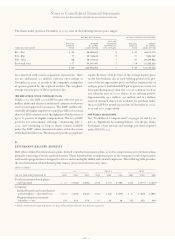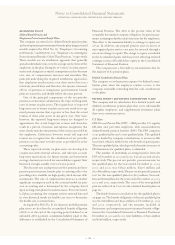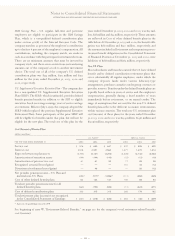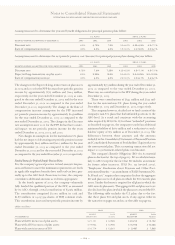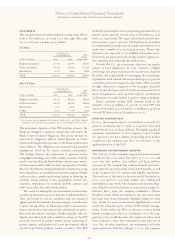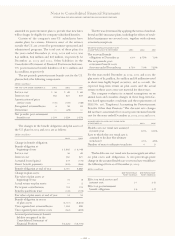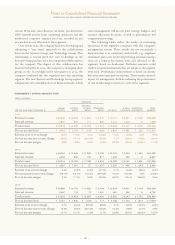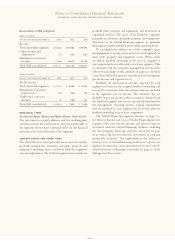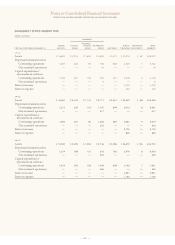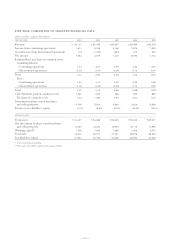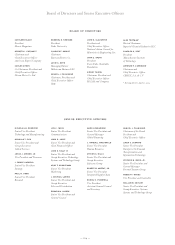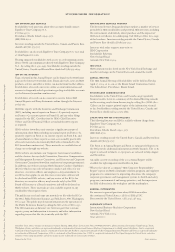IBM 2003 Annual Report Download - page 119
Download and view the complete annual report
Please find page 119 of the 2003 IBM annual report below. You can navigate through the pages in the report by either clicking on the pages listed below, or by using the keyword search tool below to find specific information within the annual report.
segment; and an Enterprise Investments segment. The seg-
ments are determined based on several factors, including
client base, homogeneity of products, technology and
delivery channels.
Information about each segment’s business and the prod-
ucts and services that generate each segment’s revenue is
located in the “Description of Business” section of the
Management Discussion on page 48 and pages 55 to 57.
In 2003, the company renamed all of its hardware segments
without changing the organization of these segments. The
Enterprise Systems segment was renamed the Systems
Group segment, the Personal and Printing Systems segment
was renamed the Personal Systems Group segment and the
Te chnology segment was renamed the Technology Group
segment.
Due to the 2002 sale of the HDD business as described in
note C, “Acquisitions/Divestitures,” on page 92 and consistent
with the “Basis of Presentation” discussed in note A,
“Significant Accounting Policies,” on page 80, the income
statement and cash flow statement information for the
Technology Group segment has been reclassified to exclude
or to separate the results of the discontinued HDD business.
Segment revenue and pre-tax income include transac-
tions between the segments that are intended to reflect an
arm’s-length transfer price. Specifically, semiconductors are
sourced internally from the Technology Group segment for
use in the manufacture of the Systems Group segment and
Personal Systems Group segment products. In addition,
hardware and software that are used by the Global Services
segment in outsourcing engagements are mostly sourced
internally from the Systems Group, Personal Systems Group
and Software segments. For the internal use of IT services,
the Global Services segment recovers cost, as well as a reason-
able fee, reflecting the arm’s-length value of providing the
services. The Global Services segment enters into arm’s-length
leases at prices equivalent to market rates with the Global
Financing segment to facilitate the acquisition of equipment
used in services engagements. Generally, all internal transac-
tion prices are reviewed and reset annually, if appropriate.
The company uses shared-resources concepts to realize
economies of scale and efficient use of resources. Thus, a con-
siderable amount of expense is shared by all of the company’s
segments. This expense represents sales coverage, marketing
and support functions such as Accounting, Treasury,
Procurement, Legal, Human Resources, and Billing and
Collections. Where practical, shared expenses are allocated
based on measurable drivers of expense, e.g., headcount.
When a clear and measurable driver cannot be identified,
shared expenses are allocated on a financial basis that is con-
sistent with the company’s management system; e.g., image
advertising is allocated based on the gross profit of the
segments. The unallocated corporate amounts arising
from certain acquisitions, indirect infrastructure reductions,
PLAN ASSETS
The company’s nonpension postretirement benefit plan
assets at December 31, 2003 and 2002 are comprised of
short-term fixed-income investments.
This plan is not funded. The company makes payments
from company funds as they become due and also maintains
a nominal, highly liquid fund balance to ensure payments are
made timely.
RECENTLY ENACTED LEGISLATION
The Medicare Prescription Drug Improvement and
Modernization Act of 2003 (the Act) was signed into law on
December 8, 2003. The Act introduces a prescription drug
benefit under Medicare (Medicare Part D) as well as a federal
subsidy to sponsors of retiree health care benefit plans that
provide a prescription drug benefit that is at least actuarially
equivalent to Medicare Part D.
SFAS No. 106, requires presently enacted changes in
relevant laws to be considered in current period measure-
ments of postretirement benefit costs and the BO. See page
116 for the BO and cost of the company’s U. S. nonpension
postretirement benefit plan.
In accordance with FSP FAS 106-1, “Accounting and
Disclosure Requirements Related to the Medicare Prescrip-
tion Drug, Improvement and Modernization Act of 2003,”
any measures of the BO or net periodic postretirement
benefit cost in the Consolidated Financial Statements or
accompanying notes do not reflect the effects of the Act on
the company’s postretirement health care plan.
The method of determining whether a sponsor’s plan will
qualify for actuarial equivalency is pending until the U.S.
Department of Health and Human Services (HHS) completes
its interpretative work on the Act. Once the interpretative
guidance is released by HHS and the FASB releases its
authoritative guidance on the appropriate method of
accounting for the subsidy, if eligible, the company could be
required to account for the subsidy (or a portion thereof) in
previously released financial statements. The FASB has not
finalized the accounting for the subsidy nor has it determined
its transition provisions.
X
segment information
IBM uses business insight and its portfolio of IT capabilities
to create client solutions. The company operates primarily in
a single industry using several segments that create value by
offering solutions that include, either singularly or in some
combination, services, software, hardware and financing.
Organizationally, the company’s major operations com-
prise a Global Services segment; a Software segment; three
hardware product segments—Systems Group, Personal
Systems Group and Technology Group; a Global Financing
Notes to Consolidated Financial Statements
INTERNATIONAL BUSINESS MACHINES CORPORATION AND SUBSIDIARY COMPANIES
117





